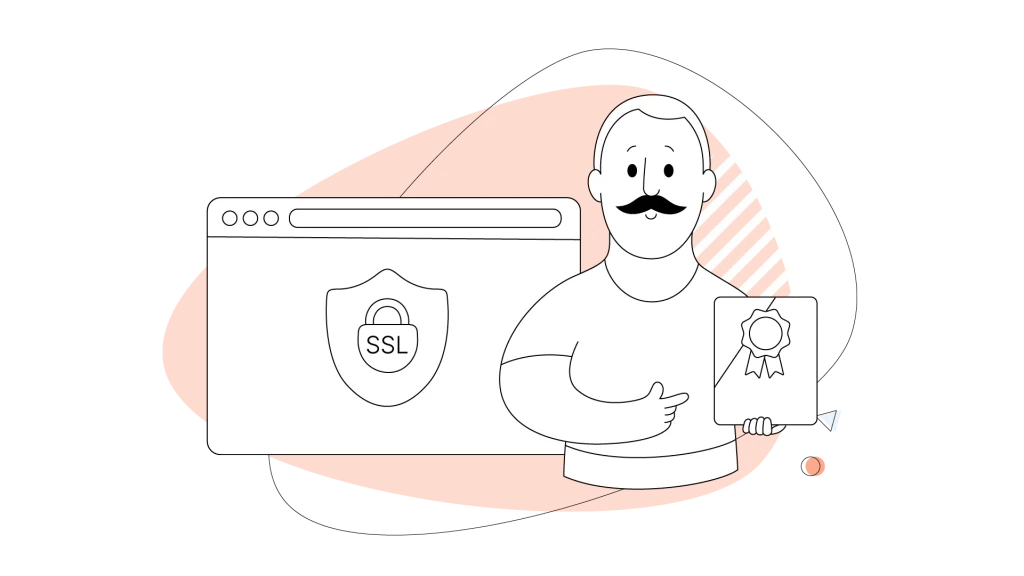If you want to appear more professional online, one key step is registering your own email domain.
It’s the most basic thing you can do to be on the web; it’s like putting a sign in your mailbox so people can send you an email.
The best thing about it? With patience, the right tools, and a little guidance, you can easily create your custom email.
In this guide, we’ll take you through the process of registering an email domain to get you up and running, and we’ll ensure that any potential pitfalls along the way don’t leave you with a knot in your throat.
What Is an Email Domain?
An email domain is the part of an email address located after the @ symbol. It typically matches your website domain and serves to identify the sender. For example, in the email address “john@acmecorp.com”, “acmecorp.com” is the email domain.
Here are the key things to know about email domains:
- Branding: An email domain that matches your website reinforces your brand identity and makes your email address more memorable.
- Professionalism: Using a custom email domain instead of a generic free email service like Gmail or Yahoo adds credibility to your communications.
- Flexibility: With your own email domain, you can create multiple email addresses for different purposes, such as “sales@yourdomain.com” or “support@yourdomain.com”.
- Ownership: When you register your own email domain, you have full control over your email addresses and your sent and received communications.
How to Register Your Email Domain
Whether you’re a business owner looking to boost your brand’s credibility or an individual who wants a free personalized email address, there are many benefits to having your own email domain.
Here’s how to register your email domain:
1. Choose a Domain Name
Choosing an email domain is one of the most important choices you can make regarding your online reputation.
Here are some things to consider:
- Short and simple is best: Aim for a concise domain name that’s easy to spell and pronounce. Avoid overly long or complicated names that could confuse people or lead to typos.
- Align with your brand: Your email domain should closely match your website domain and business name. This consistency strengthens your brand recognition and makes your email address more intuitive for customers and contacts.
- Consider your target audience: If you serve a local market, consider including your geographic location in your domain (e.g., “nyccatering.com”).
- Steer clear of numbers and hyphens: While it may be tempting to include numbers or hyphens to secure an available domain, these elements can make your email address harder to remember and share verbally. Stick with plain words whenever possible.
- Check the domain’s history: Before settling on a domain, research its past usage to ensure it hasn’t been associated with spam, scams, or unsavory content. You can use tools like Wayback Machine to see archived versions of the domain’s website.
2. Select the Right Domain Extension
Your email domain’s extension (the part after the dot, like .com or .net) influences how people perceive your brand. Some tips for choosing an extension:
- .com is still king: If available, .com is the most universally recognized and trusted domain extension. It’s the safest choice for businesses with a global audience.
- Location-specific extensions add local flavor: If you primarily serve customers in a specific country, consider using a country code top-level domain like .co.uk for the United Kingdom, .ca for Canada or .hk for Hong Kong. This can boost your local SEO and show your community ties.
- Niche extensions can highlight your industry: Newer generic top-level domains like .cloud, .host, or .tech can emphasize what you do and help you stand. However, be aware that some users may be less familiar with these extensions.
Protect Your Brand with Multiple Registrations
To prevent competitors or copycats from using your brand name, consider registering your domain with multiple extensions. For example, if your main domain is yourbusiness.com, you might also register yourbusiness.net, yourbusiness.biz, and yourbusiness.info.
You can point these additional domains to your primary website to maintain brand consistency and avoid confusion.
3. Set Your Registration Term and Auto-Renewals
When registering your email domain, you’ll need to choose the length of your registration period. Most registrars offer terms ranging from 1-10 years.
- Longer terms save you money: Registering your domain for multiple years upfront can lock in a lower price and protect you from annual price increases.
- Auto-renewals prevent downtime: Enable auto-renewal for your domain to avoid accidentally letting your registration expire. An expired domain becomes available for anyone to register, putting your brand and email continuity at risk.
4. Safeguard Your Privacy with WHOIS Protection
The Internet Corporation for Assigned Names and Numbers (ICANN) requires domain registrars to maintain a public WHOIS database listing the contact information of every domain owner.
However, you can keep your personal details private with WHOIS privacy protection, a service that replaces your information with your registrar’s contact details.
Domain privacy is crucial to:
- Reduce spam and unwanted solicitations: The WHOIS database is a common source for email and phone spammers scraping contact details.
- Prevent identity theft: Hackers and scammers can use the personal information in WHOIS records for social engineering attacks and identity theft attempts.
- Protect your home address: If your business is home-based, domain privacy keeps your personal address confidential.
Many registrars offer WHOIS privacy as an add-on. Some include it for free with your domain registration.
5. Set Up Your Email Hosting and DNS Records
With your email domain registered, you need to configure your email hosting and DNS settings. Email hosting is a service that stores and manages your email accounts and messages on a server.
Many web hosting providers include email hosting in their plans, or you can choose a dedicated email hosting service for more advanced features and reliability.
After selecting your email host, access your domain registrar’s control panel to update your DNS records:
- MX Records: Mail Exchanger (MX) records specify the mail servers responsible for accepting email messages on behalf of your domain. Add MX records provided by your email host.
- SPF Records: Sender Policy Framework (SPF) records list the mail servers authorized to send emails from your domain. This helps prevent spammers from sending unauthorized emails using your domain name.
- DKIM Records: DomainKeys Identified Mail (DKIM) records add a digital signature to your email headers to verify the authenticity of your messages and prevent tampering in transit.
Properly configuring these records ensures reliable email delivery and protects your domain’s reputation.
6. Create Email Accounts for Your Domain
In your email hosting control panel, create email addresses for the various roles and individuals in your organization. Some common examples include:
- info@yourdomain.com
- sales@yourdomain.com
- support@yourdomain.com
- john.smith@yourdomain.com
Consider creating variations or aliases for key addresses (e.g., john@yourdomain.com and jsmith@yourdomain.com) to catch potential misspellings.
You can also set up group email addresses (e.g., team@yourdomain.com) to deliver messages to multiple recipients at once.
7. Verify Your Email Setup and Start Sending
Before announcing your new email addresses, send test messages to and from your accounts to verify that everything is working correctly.
Check Email Sending and Receiving
Send a message from each of your new email addresses to a personal email address at a different domain. Then, reply to those messages from your personal address back to your domain email accounts.
Open the test messages to confirm they were delivered successfully and displayed correctly in your email client.
Review Email Authentication Records
Use an email authentication tool like MX Toolbox to check your domain’s MX, SPF, and DKIM records for any misconfigurations.
These tools will verify that your records are set up correctly and identify any issues that could impact email delivery, such as conflicting or missing records.
Gradually Transition to Your New Email Domain
To minimize disruption, notify your contacts and update your email address on your website, business cards, and other materials.
Consider setting up email forwarding from your old email address to your new domain during the transition period. This ensures you continue receiving important messages while you update your contact information.
Benefits of Registering Your Own Email Domain
There are many advantages to registering your own email domain, which can help with your company’s web presence and overall ability to function and be flexible.
It is so much more than just getting your own personalized email address; it helps you build trust and credibility with your audience, protects your brand, improves email deliverability, and allows you to move providers easily and without restrictions.
It also allows you to establish your own addresses that are tailored to your specific business needs.
Let’s take a look at some of the benefits of running your own email domain:
- Builds trust and credibility: A professional email address using your own domain sets a positive impression and establishes trust with your audience right from their inbox. It signals that you’re serious about your business.
- Protects your brand online: When you register an email domain, you secure exclusive rights to brand representation in email communications, safeguarding your brand identity across the web.
- Improves email deliverability: Email addresses with custom domains are less likely to be flagged as spam compared to free email services, ensuring your messages reach their intended recipients.
- Provides flexibility to change providers: Owning your email domain allows you to switch email hosting services without changing your email address, giving you the freedom to choose the best service for your needs.
- Enables custom addresses for different needs: Personalize your communication strategy with multiple custom email addresses, such as support@ or sales@yourdomain.com, to cater to various aspects of your business.
Conclusion
One of the quickest ways to boost a brand’s professional image is to register an email domain and set up an email address with it. This ensures that your chosen business name, typically the domain name of your website, will have a matching email address.
Be sure to pick a domain that reflects your brand, set up DKIM, SPF, and DMARC records, and let your contacts know you’ve changed your email address.
With an email domain of your own, you’re halfway to establishing a reputable online identity for the organization.
Are you looking to take your online business to the next level? If so, one thing you don’t want to skimp on is your email domain. Having your own domain can add credibility to your brand and ensure that your audience can easily reach you. HostPapa’s exclusive domain registration can help make this process easy.
How to Register an Email Domain: Frequently Asked Questions
What Is the Difference Between a Domain Name and an Email Domain?
A domain name is your website’s address on the internet, while an email domain is part of an email address that follows the @ symbol and represents the mail server that handles your emails.
Do I Need Web Hosting to Use an Email Domain?
No, you don’t necessarily need web hosting to use an email domain. However, many web hosting packages include email hosting, offering a convenient way to manage both services under one provider.
Can I Transfer My Email Domain to Another Registrar?
Yes, you can transfer your email domain to another registrar. The process involves unlocking the domain at your current registrar and obtaining a transfer code to initiate the transfer with the new provider.




